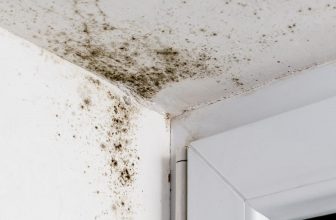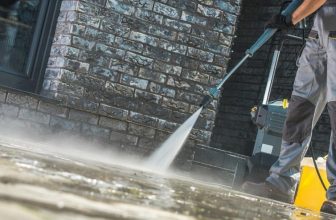Anyone who has spent a lot of time and/or money having their concrete driveway set up, or anyone who just wants to keep their driveway looking its best is going to want to read this article. That’s because we’re going to go over some of the tips and tricks that homeowners can use to make sure that their driveway looks as good as it did when it was first installed.
Clean & Seal The Driveway Regularly
One of the first things that homeowners can do to keep their driveway in good condition is to make sure that it’s cleaned regularly and that it’s also sealed as needed. Of course, we can’t tell homeowners exactly how often they should clean and reseal their driveway because it depends on several different factors. It depends upon the weather, how much sunlight the driveway receives, and how much traffic it receives. However, as a general rule, homeowners should think about cleaning the driveway as needed and resealing approximately every two years or so.
Make Sure That Stains Are Immediately Removed
The purpose of using a sealer on your concrete driveway is to make sure that stains caused by oil, grease, and gasoline don’t get absorbed by the concrete and permanently stain it. However, that doesn’t mean that the stains shouldn’t be removed as quickly as possible. After all, gasoline and oil can have a corrosive effect on the driveway sealant, leading to a condition where they make it through the sealant and end up staining the concrete. To avoid this problem, make sure to promptly clean up messes on the driveway using a pressure washer and the proper cleaning chemicals for your driveway.
Be Careful With Snow Removal
Another suggestion for keeping the driveway in good condition is to be careful with snow removal. This means trying to avoid scraping the surface of the driveway with the blade of the snow shovel—at least, as much as is humanly possible. It’s also a good idea to avoid using chemical deicing products on the surface. And if the homeowner has to use salt for removing snow, they should avoid doing it the first year after the driveway was installed. It’s better to not use salt at all on a concrete driveway, but especially during the first year.
Don’t Overestimate Its Strength
One of the ways that some people end up damaging their concrete driveway is by overestimating its strength. They end up parking heavy equipment on it such as a backhoe or a dump truck—when in reality, the driveway wasn’t designed to hold that amount of weight. That’s why homeowners should limit the use of their driveway to parking their motorcycle, car, truck, or van and not big equipment.
Choose The Best Concrete Sealers
When it comes to driveway sealers, the consumer has a lot of choices available to them. There are acrylic sealers, polyurethanes, penetrating resins, and epoxies. Consumers need to do their research and choose the appropriate sealer for their concrete driveway. They should also keep in mind that some concrete sealant products are designed for the inside of garages, so some of these products will yellow over time if they’re exposed to sunlight.
Apply The Concrete Sealer Properly
Although it’s beyond the scope of this guide to give all of our reader’s step-by-step instructions on how to use whatever concrete sealer they have bought for their driveway, we can give some general tips that all of our readers can apply to their particular situation.

Tip One: Allow The Concrete To Cure Properly
When new concrete is installed, it needs to be allowed to properly cure. For most concrete driveways, that’s approximately 28-30 days, but that time frame might be smaller if the homeowner is using a product that speeds up the curing process.
Tip Two: Read The Product’s Instructions Fully
It’s also a good idea for the concrete sealer’s label to be fully read and understood before the consumer decides to use it. That means following all of the safety steps included in the instructions and following all of the application steps exactly as the label has listed it.
Tip Three: Apply The Sealant At The Right Time
Although sealants indeed differ from one type to the next, for most products, it’s a good idea to seal the concrete when the weather is above 50-degrees and rain isn’t anticipated. This will ensure that the consumer can apply the sealant and that it will have time to properly set.
Tip Four: Apply The Sealant In Thin Coats
Another valuable tip that we can give our readers is for them to make sure that they apply their sealant in thin coats. This will ensure that the product doesn’t pool up in some areas, and will ensure proper coverage of the sealant over the entire surface of the driveway.
Tip Five: Use The Proper Equipment
When applying the product, the consumer should make sure that they have the best equipment for the job as expressed by the sealant’s instructions. This can include wearing gloves while applying the product, using a sprayer for solvent-based sealers, or using a roller for water-based sealers.
Tip Six: Two Coats Is Usually Best
Unless the label of your sealer specifically states that only one coat of it should be used, it’s best to put down a second coat for the best results. This is done by waiting the proper amount of time for the first coat to dry and then applying the second coat according to the product’s label.
Tip Seven: Reseal As Necessary
Although a concrete sealer lasts awhile before it needs to be reapplied, not all of them will last as long as the driveway does and will need to be reapplied. The following general rules are estimates of the average amount of time that a particular type of sealer will last. Of course, those are estimates, so the times may differ for specific products and it’s up to the consumer to decide for themselves when their driveway needs to be resealed.
- Silicate, Siloxane, And Silane Sealers Generally Last The Lifetime Of The Driveway
- Epoxies, Polyaspartics and Polyurethane Products Last Up To 10-Years
- Soft Acrylic Sealers Last Approximately 3-years.





